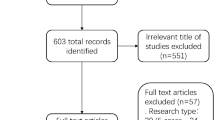Abstract
The TDR Diagnostics Evaluation Expert Panel
This is a preview of subscription content, access via your institution
Access options
Subscribe to this journal
Receive 12 print issues and online access
$209.00 per year
only $17.42 per issue
Buy this article
- Purchase on Springer Link
- Instant access to full article PDF
Prices may be subject to local taxes which are calculated during checkout

Similar content being viewed by others
Change history
27 March 2018
This article was initially published with an incorrect DOI. A new DOI has been assigned and registered at Crossref, and has been corrected in the article.
References
Greenhalgh, T. How to read a paper: papers that report diagnostic or screening tests. Br. Med. J. 315, 540–543 (1997).
Borriello, S. P. Near-patient microbiological tests. Br. Med. J. 319, 298–301 (1999).
Bossuyt, P. M. et al. Towards complete and accurate reporting of studies of diagnostic accuracy: the STARD Initiative. Clin. Chem. 49, 1–6 (2003).
Bossuyt, P. M. et al. The STARD statement for reporting studies of diagnostic accuracy: explanation and elaboration. Clin. Chem. 49, 7–18 (2003).
Smith, P. G. & Morrow, R. H., eds Field Trials of Health Interventions in Developing Countries: A Toolbox, (Macmillan, London, 1996).
Alonzo, T. D & Pepe, M. S. Using a combination of reference tests to assess the accuracy of a new diagnostic test. Statist. Med. 18, 2987–3003 (1999).
Pepe, M. S. Statistical Evaluation of Medical Tests for Classification and Prediction. (Oxford Univ. Press, 2003).
Gardner, M. J. & Altman, D. G. Estimating with confidence. Br. Med. J. 296, 1210–1211 (1988).
McGinn, T. et al. Tips for learners of evidence-based medicine: 3. Measures of observer variability (kappa statistic). Can. Med. Assoc. J. 171, 1369–1373 (2004).
WHO. Standard Operating Procedures for Clinical Investigators. UNDP/World Bank/WHO Special Programme for Research and Training in Tropical Diseases (WHO/TDR). TDR/ TDP/SOP99.1 <[online]> (1999)
WHO/Council for International Organizations of Medical Sciences. International Ethical Guidelines for Biomedical Research Involving Human Subjects (2002).
Nuffield Council on Bioethics. The Ethics of Research Related to Healthcare in Developing Countries <[online]> (2002)
WHO. Guidelines for Good Laboratory Practice. UNDP/World Bank/WHO Special Programme for Research and Training in Tropical Diseases TDR/ PRD/GLP/01.2 (WHO/TDR, Geneva, 2001).
Delaney, B. C. et al. Systematic review of near-patient test evaluations in primary care. Br. Med. J. 319, 824–827 (1999).
Reid, M. C., Lachs, M. S. & Feinstein, A. Use of methodological standards in diagnostic test research. Getting better but still not good. J. Amer. Med. Assoc. 274, 645–651 (1995).
Small, P. M. & Perkins, M. D. More rigour needed in trials of new diagnostic agents for tuberculosis. Lancet 356, 1048–1049 (2000).
Acknowledgements
We wish to thank Izabela Suder-Dayao for excellent secretarial support, and Robert Ridley and Giorgio Roscigno for support and guidance.
Author information
Authors and Affiliations
Corresponding author
Supplementary information
Appendix 1
Standards for reporting of diagnostic accuracy (STARD) list (PDF 100 kb)
Appendix 2
Sample informed consent form (PDF 99 kb)
Glossary
- Accuracy
-
The percentage of correct results obtained by the test under evaluation compared with the results of a reference or 'gold standard' test. Usually expressed as the number of correct results divided by the total number of results, multiplied by 100.
- Blinding
-
Interpreting a test result without knowledge of a patient's condition or previous test results.
- Confidence interval
-
The confidence interval quantifies the uncertainty in measurement; usually reported as the 95% confidence interval, the range that we can be 95% certain covers the true value.
- Negative predictive value (NPV)
-
The probability that a negative result accurately indicates the absence of infection.
- Positive predictive value (PPV)
-
The probability that a positive result accurately indicates the presence of infection.
- Prevalence
-
The proportion of a given population with an infection at a given time.
- Proficiency panel
-
A collection of six or more mock or true specimens with positive and negative results for a particular test, used to ascertain the proficiency of the technologist in performing the test.
- Quality assurance (QA)
-
An ongoing process of monitoring a system for reproducibility or reliability of results, with which corrective action can be instituted if standards are not met.
- Reference standard
-
The best available approximation of a true result, generally indicating a test method that is currently accepted as reasonably, but not necessarily, 100% accurate. It is used as the reference method for assessing the performance characteristics of another test method.
- Reproducibility
-
A measure of the extent to which replicate analyses using identical procedures agree with each other.
- Sensitivity
-
The probability (percentage) that patients with the infection (determined by the result of the reference or 'gold standard' test) will have a positive result using the test under evaluation.
- Specificity
-
The probability (percentage) that patients without the infection (determined by the result of the reference or 'gold standard' test) will have a negative result using the test under evaluation.
- Tests
-
Any method for obtaining additional information regarding a patient's health status.
Rights and permissions
About this article
Cite this article
Banoo, S., Bell, D., Bossuyt, P. et al. Evaluation of diagnostic tests for infectious diseases: general principles. Nat Rev Microbiol 5 (Suppl 11), S21–S31 (2007). https://doi.org/10.1038/nrmicro1523x
Issue Date:
DOI: https://doi.org/10.1038/nrmicro1523x



